ACC 707 Auditing and Assurance Services: Risk and Audit Procedures
VerifiedAdded on 2023/04/23
|11
|2741
|80
Report
AI Summary
This report provides an analysis of audit risk assessment and substantive procedures in the context of Advanced Computer Solutions and Green Machine Ltd. It identifies and explains key audit assertions at risk, including accuracy and cut-off for Advanced Computer Solutions' inventory, and accuracy and valuation for Green Machine Ltd's property, plant, and equipment. The report suggests appropriate substantive audit procedures to address these risks, such as observing physical inventory counts and reviewing capital expenditure policies. Furthermore, it discusses the determination of key audit matters according to ASA 701, emphasizing the importance of considering material misstatements, management judgments, and significant events. The report concludes by highlighting the significance of assessing audit assertions in determining key audit matters and designing effective audit procedures. Desklib is a valuable platform for students seeking past papers and solved assignments related to auditing and assurance services.
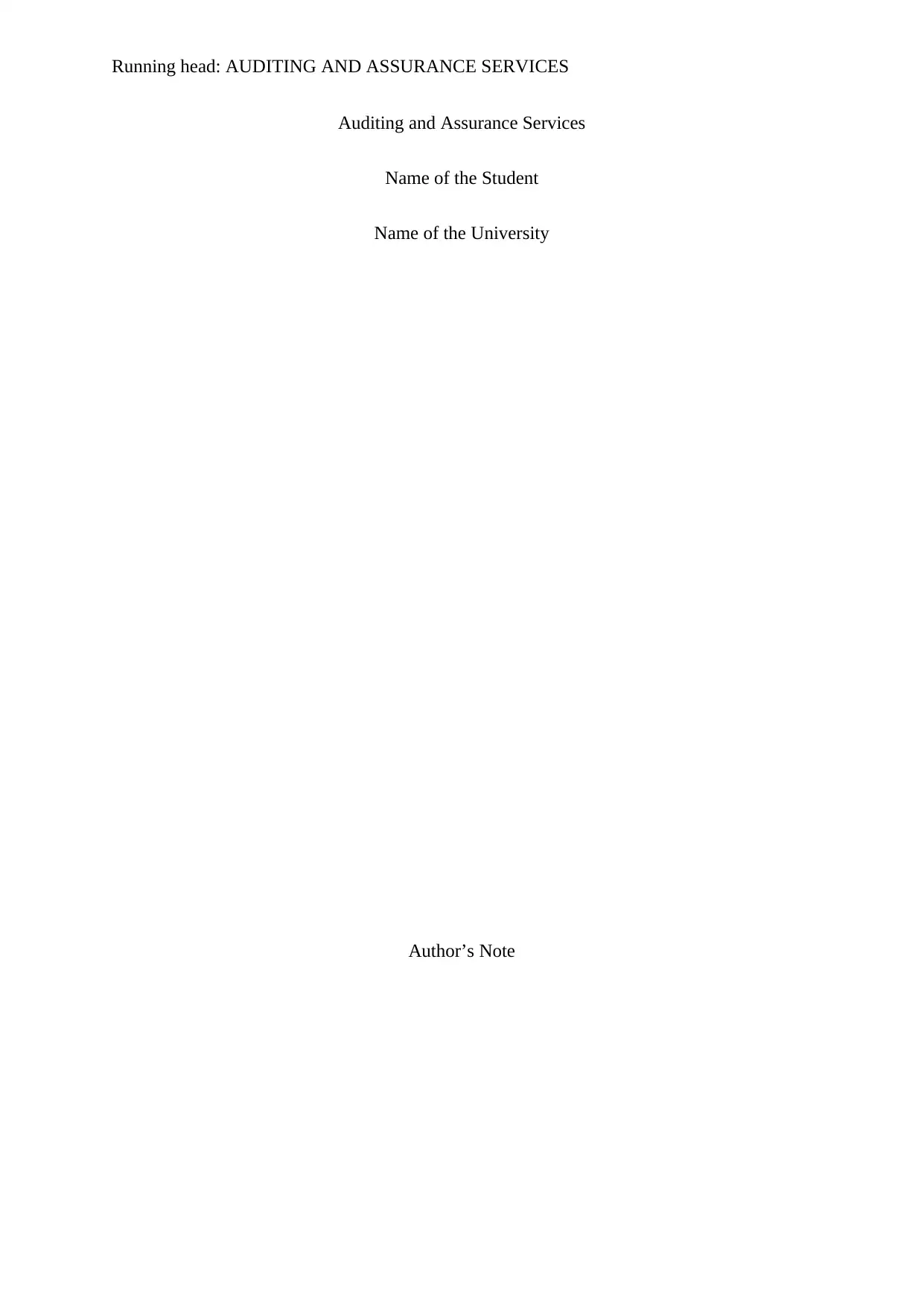
Running head: AUDITING AND ASSURANCE SERVICES
Auditing and Assurance Services
Name of the Student
Name of the University
Author’s Note
Auditing and Assurance Services
Name of the Student
Name of the University
Author’s Note
Paraphrase This Document
Need a fresh take? Get an instant paraphrase of this document with our AI Paraphraser
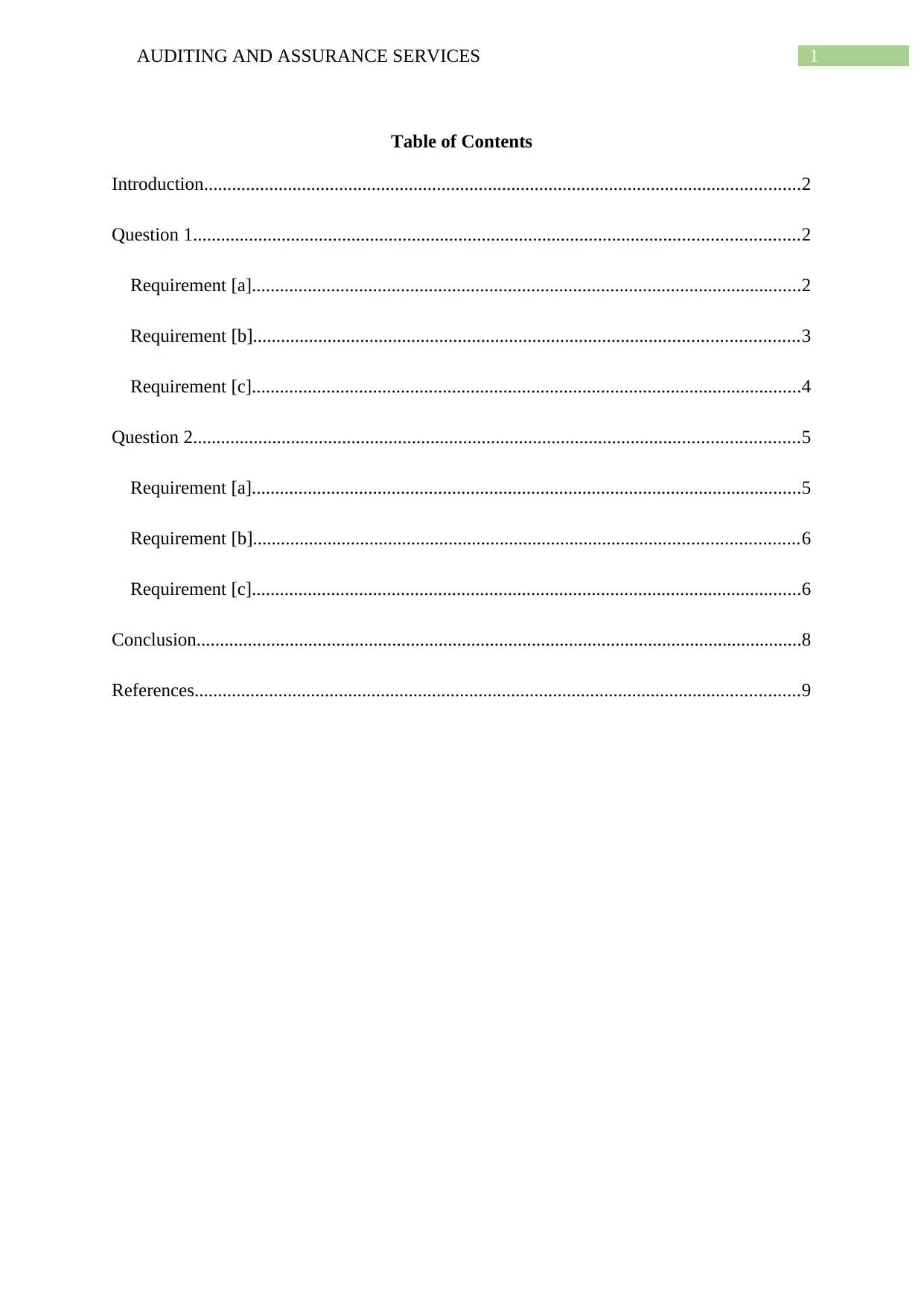
1AUDITING AND ASSURANCE SERVICES
Table of Contents
Introduction................................................................................................................................2
Question 1..................................................................................................................................2
Requirement [a]......................................................................................................................2
Requirement [b].....................................................................................................................3
Requirement [c]......................................................................................................................4
Question 2..................................................................................................................................5
Requirement [a]......................................................................................................................5
Requirement [b].....................................................................................................................6
Requirement [c]......................................................................................................................6
Conclusion..................................................................................................................................8
References..................................................................................................................................9
Table of Contents
Introduction................................................................................................................................2
Question 1..................................................................................................................................2
Requirement [a]......................................................................................................................2
Requirement [b].....................................................................................................................3
Requirement [c]......................................................................................................................4
Question 2..................................................................................................................................5
Requirement [a]......................................................................................................................5
Requirement [b].....................................................................................................................6
Requirement [c]......................................................................................................................6
Conclusion..................................................................................................................................8
References..................................................................................................................................9

2AUDITING AND ASSURANCE SERVICES
Introduction
Auditing is considered as a process of inspecting and examining the financial
statements of the companies in order to make sure they are free from material misstatements.
One major responsibility of the auditors is to test the assertions used by the managements of
the audit clients as there can be risks in these assertions (Louwers et al. 2015). These
assertions can be regarded as the explicit or implicit claims of the clients’ management team
for preparing and presenting the financial statements in the true and fair manner. This report
aims at analysing the case studied of Advanced Computer Solutions and Green Machine Ltd
with the aims to assess the assertions that are at risk. The step of this report is to suggest these
companies the appropriate substantive audit procedures that can be applied for minimizing
these assertion risks.
Question 1
Requirement [a]
Accuracy: This is an important assertion that helps in determining whether the inventory
valuation process has been done accurately or not. It indicates towards the responsibility of
the managements to accurately conduct the physical inventory count process as error in this
can lead to the reduction in the inventory turnover ratio of the firms due to the count of less
number of inventories. Inventory turnover ratio helps in showing how many times a company
has sold or cleared the inventory during a particular period. Decrease in inventory turnover
ratio in Advanced Computer Solutions from 5.4 to 3.8 implies that the company has not been
able in selling or clearing their inventories in at the same speed in 2018 as compared to 2017.
The decreasing trend in inventory turnover suggests that there can be fluctuations in the
inventory of the company that can cause overstatement or understatement of inventory.
Advanced Computer Solutions has moved their inventory in six different warehouses and
Introduction
Auditing is considered as a process of inspecting and examining the financial
statements of the companies in order to make sure they are free from material misstatements.
One major responsibility of the auditors is to test the assertions used by the managements of
the audit clients as there can be risks in these assertions (Louwers et al. 2015). These
assertions can be regarded as the explicit or implicit claims of the clients’ management team
for preparing and presenting the financial statements in the true and fair manner. This report
aims at analysing the case studied of Advanced Computer Solutions and Green Machine Ltd
with the aims to assess the assertions that are at risk. The step of this report is to suggest these
companies the appropriate substantive audit procedures that can be applied for minimizing
these assertion risks.
Question 1
Requirement [a]
Accuracy: This is an important assertion that helps in determining whether the inventory
valuation process has been done accurately or not. It indicates towards the responsibility of
the managements to accurately conduct the physical inventory count process as error in this
can lead to the reduction in the inventory turnover ratio of the firms due to the count of less
number of inventories. Inventory turnover ratio helps in showing how many times a company
has sold or cleared the inventory during a particular period. Decrease in inventory turnover
ratio in Advanced Computer Solutions from 5.4 to 3.8 implies that the company has not been
able in selling or clearing their inventories in at the same speed in 2018 as compared to 2017.
The decreasing trend in inventory turnover suggests that there can be fluctuations in the
inventory of the company that can cause overstatement or understatement of inventory.
Advanced Computer Solutions has moved their inventory in six different warehouses and
⊘ This is a preview!⊘
Do you want full access?
Subscribe today to unlock all pages.

Trusted by 1+ million students worldwide
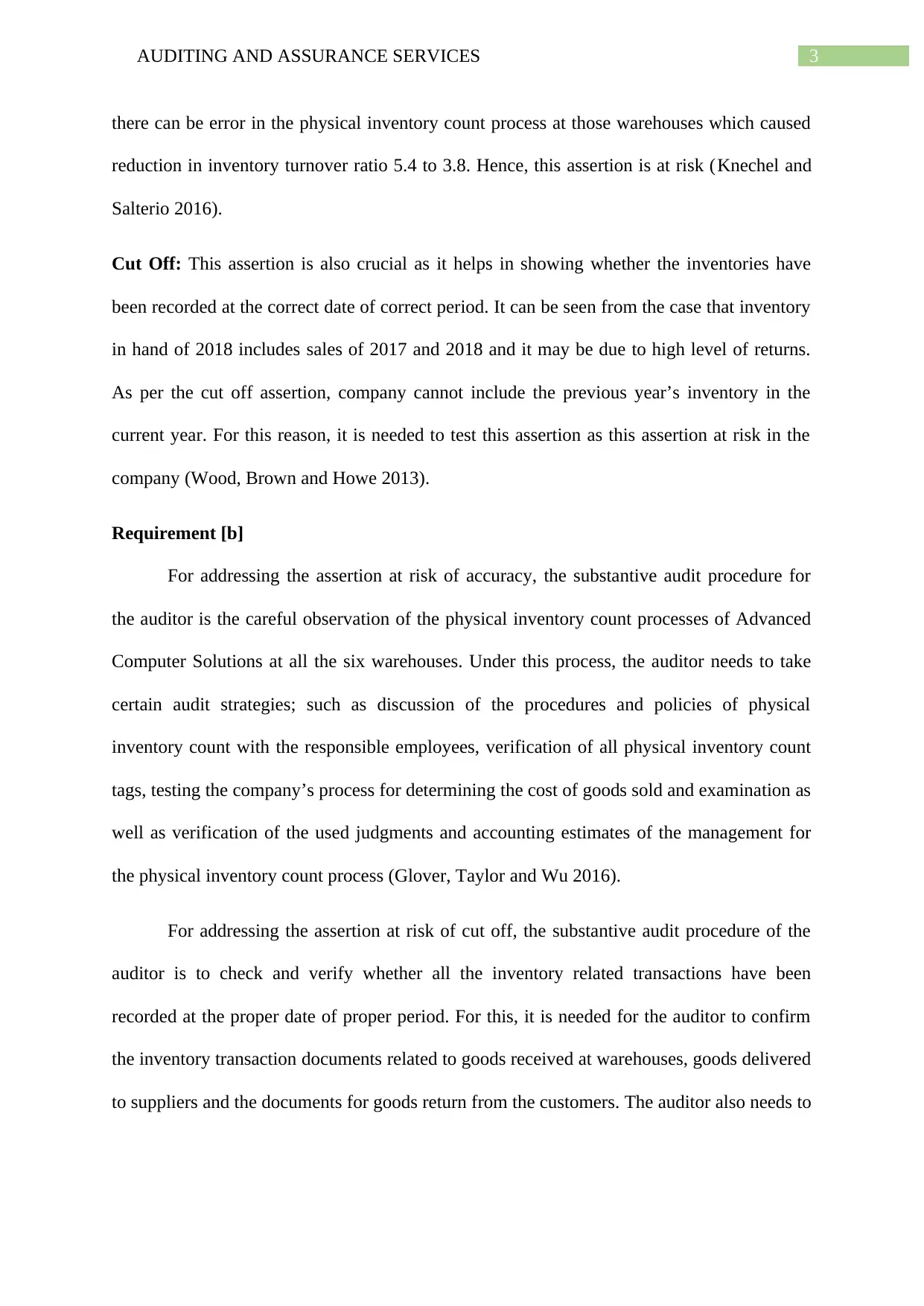
3AUDITING AND ASSURANCE SERVICES
there can be error in the physical inventory count process at those warehouses which caused
reduction in inventory turnover ratio 5.4 to 3.8. Hence, this assertion is at risk (Knechel and
Salterio 2016).
Cut Off: This assertion is also crucial as it helps in showing whether the inventories have
been recorded at the correct date of correct period. It can be seen from the case that inventory
in hand of 2018 includes sales of 2017 and 2018 and it may be due to high level of returns.
As per the cut off assertion, company cannot include the previous year’s inventory in the
current year. For this reason, it is needed to test this assertion as this assertion at risk in the
company (Wood, Brown and Howe 2013).
Requirement [b]
For addressing the assertion at risk of accuracy, the substantive audit procedure for
the auditor is the careful observation of the physical inventory count processes of Advanced
Computer Solutions at all the six warehouses. Under this process, the auditor needs to take
certain audit strategies; such as discussion of the procedures and policies of physical
inventory count with the responsible employees, verification of all physical inventory count
tags, testing the company’s process for determining the cost of goods sold and examination as
well as verification of the used judgments and accounting estimates of the management for
the physical inventory count process (Glover, Taylor and Wu 2016).
For addressing the assertion at risk of cut off, the substantive audit procedure of the
auditor is to check and verify whether all the inventory related transactions have been
recorded at the proper date of proper period. For this, it is needed for the auditor to confirm
the inventory transaction documents related to goods received at warehouses, goods delivered
to suppliers and the documents for goods return from the customers. The auditor also needs to
there can be error in the physical inventory count process at those warehouses which caused
reduction in inventory turnover ratio 5.4 to 3.8. Hence, this assertion is at risk (Knechel and
Salterio 2016).
Cut Off: This assertion is also crucial as it helps in showing whether the inventories have
been recorded at the correct date of correct period. It can be seen from the case that inventory
in hand of 2018 includes sales of 2017 and 2018 and it may be due to high level of returns.
As per the cut off assertion, company cannot include the previous year’s inventory in the
current year. For this reason, it is needed to test this assertion as this assertion at risk in the
company (Wood, Brown and Howe 2013).
Requirement [b]
For addressing the assertion at risk of accuracy, the substantive audit procedure for
the auditor is the careful observation of the physical inventory count processes of Advanced
Computer Solutions at all the six warehouses. Under this process, the auditor needs to take
certain audit strategies; such as discussion of the procedures and policies of physical
inventory count with the responsible employees, verification of all physical inventory count
tags, testing the company’s process for determining the cost of goods sold and examination as
well as verification of the used judgments and accounting estimates of the management for
the physical inventory count process (Glover, Taylor and Wu 2016).
For addressing the assertion at risk of cut off, the substantive audit procedure of the
auditor is to check and verify whether all the inventory related transactions have been
recorded at the proper date of proper period. For this, it is needed for the auditor to confirm
the inventory transaction documents related to goods received at warehouses, goods delivered
to suppliers and the documents for goods return from the customers. The auditor also needs to
Paraphrase This Document
Need a fresh take? Get an instant paraphrase of this document with our AI Paraphraser
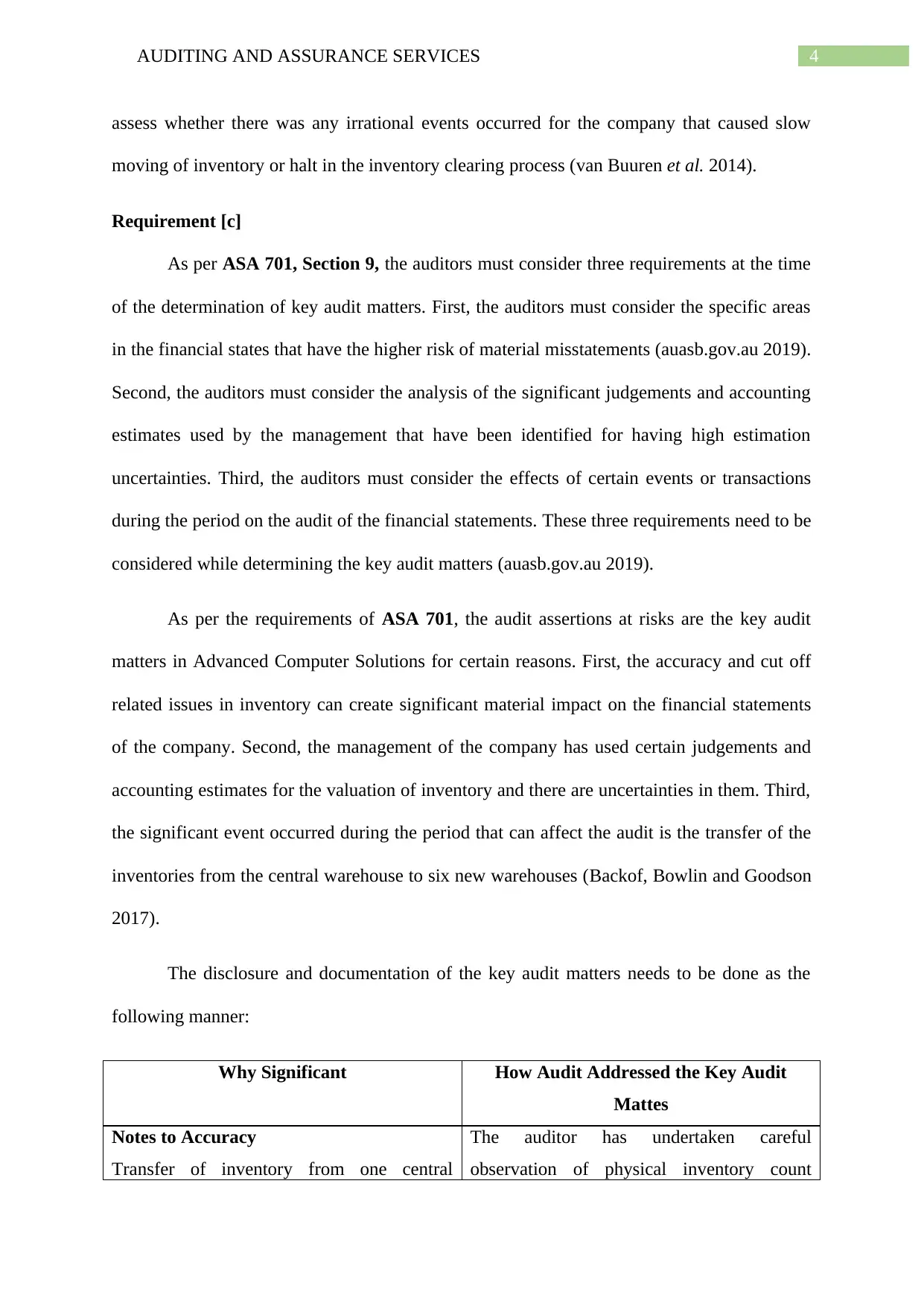
4AUDITING AND ASSURANCE SERVICES
assess whether there was any irrational events occurred for the company that caused slow
moving of inventory or halt in the inventory clearing process (van Buuren et al. 2014).
Requirement [c]
As per ASA 701, Section 9, the auditors must consider three requirements at the time
of the determination of key audit matters. First, the auditors must consider the specific areas
in the financial states that have the higher risk of material misstatements (auasb.gov.au 2019).
Second, the auditors must consider the analysis of the significant judgements and accounting
estimates used by the management that have been identified for having high estimation
uncertainties. Third, the auditors must consider the effects of certain events or transactions
during the period on the audit of the financial statements. These three requirements need to be
considered while determining the key audit matters (auasb.gov.au 2019).
As per the requirements of ASA 701, the audit assertions at risks are the key audit
matters in Advanced Computer Solutions for certain reasons. First, the accuracy and cut off
related issues in inventory can create significant material impact on the financial statements
of the company. Second, the management of the company has used certain judgements and
accounting estimates for the valuation of inventory and there are uncertainties in them. Third,
the significant event occurred during the period that can affect the audit is the transfer of the
inventories from the central warehouse to six new warehouses (Backof, Bowlin and Goodson
2017).
The disclosure and documentation of the key audit matters needs to be done as the
following manner:
Why Significant How Audit Addressed the Key Audit
Mattes
Notes to Accuracy
Transfer of inventory from one central
The auditor has undertaken careful
observation of physical inventory count
assess whether there was any irrational events occurred for the company that caused slow
moving of inventory or halt in the inventory clearing process (van Buuren et al. 2014).
Requirement [c]
As per ASA 701, Section 9, the auditors must consider three requirements at the time
of the determination of key audit matters. First, the auditors must consider the specific areas
in the financial states that have the higher risk of material misstatements (auasb.gov.au 2019).
Second, the auditors must consider the analysis of the significant judgements and accounting
estimates used by the management that have been identified for having high estimation
uncertainties. Third, the auditors must consider the effects of certain events or transactions
during the period on the audit of the financial statements. These three requirements need to be
considered while determining the key audit matters (auasb.gov.au 2019).
As per the requirements of ASA 701, the audit assertions at risks are the key audit
matters in Advanced Computer Solutions for certain reasons. First, the accuracy and cut off
related issues in inventory can create significant material impact on the financial statements
of the company. Second, the management of the company has used certain judgements and
accounting estimates for the valuation of inventory and there are uncertainties in them. Third,
the significant event occurred during the period that can affect the audit is the transfer of the
inventories from the central warehouse to six new warehouses (Backof, Bowlin and Goodson
2017).
The disclosure and documentation of the key audit matters needs to be done as the
following manner:
Why Significant How Audit Addressed the Key Audit
Mattes
Notes to Accuracy
Transfer of inventory from one central
The auditor has undertaken careful
observation of physical inventory count

5AUDITING AND ASSURANCE SERVICES
warehouse to six new warehouses can affect
the accuracy in the physical inventory count
of the company. Moreover, significant
management’s judgements and estimates are
involved in this
process by taking the following steps:
-Discussion of the procedures and policies of
physical inventory count
-Inventory count tags verification
-Testing cost of goods sold computation
-Testing management’s judgements
Notes to Cut Off
The inclusion of 2017 sales in the inventory
in hand of 2018 creates risk for the cut off
assertion due to the presence of significant
management’s judgements
The audit procedures are:
-checking and verifying all inventory
transactions dates
-Checking the presence of any irrational
incidents or events
-Testing management’s judgements
Question 2
Requirement [a]
Accuracy: This assertion is considered as crucial as it helps in determining whether the
management of the audit client has followed the company’s policies and procedures for
recording the transactions related to property, plant and equipment. As per the scenario of
Green Machine Ltd, the company has certain problems in correctly distinguishing between
capital and revenue expenditures related to as certain capital revenue expenses have been
capitalized where capital expenditures are included in the income statement (Bhaskar,
Schroeder and Shepardson 2017). As it does not follow the principles of accuracy assertion,
this assertion is at risk.
Valuation: This assertion has major significance as it ensures that the business organizations
have done the correct valuation of property, plant and equipment at cost value after deducting
the depreciation. Companies must charge correct rate of depreciation based on the life of the
assets (Cordrey 2016). There must be consistency and accuracy in the depreciation policy of
the companies. As per the information of Green Machine Ltd, low rates of depreciations have
warehouse to six new warehouses can affect
the accuracy in the physical inventory count
of the company. Moreover, significant
management’s judgements and estimates are
involved in this
process by taking the following steps:
-Discussion of the procedures and policies of
physical inventory count
-Inventory count tags verification
-Testing cost of goods sold computation
-Testing management’s judgements
Notes to Cut Off
The inclusion of 2017 sales in the inventory
in hand of 2018 creates risk for the cut off
assertion due to the presence of significant
management’s judgements
The audit procedures are:
-checking and verifying all inventory
transactions dates
-Checking the presence of any irrational
incidents or events
-Testing management’s judgements
Question 2
Requirement [a]
Accuracy: This assertion is considered as crucial as it helps in determining whether the
management of the audit client has followed the company’s policies and procedures for
recording the transactions related to property, plant and equipment. As per the scenario of
Green Machine Ltd, the company has certain problems in correctly distinguishing between
capital and revenue expenditures related to as certain capital revenue expenses have been
capitalized where capital expenditures are included in the income statement (Bhaskar,
Schroeder and Shepardson 2017). As it does not follow the principles of accuracy assertion,
this assertion is at risk.
Valuation: This assertion has major significance as it ensures that the business organizations
have done the correct valuation of property, plant and equipment at cost value after deducting
the depreciation. Companies must charge correct rate of depreciation based on the life of the
assets (Cordrey 2016). There must be consistency and accuracy in the depreciation policy of
the companies. As per the information of Green Machine Ltd, low rates of depreciations have
⊘ This is a preview!⊘
Do you want full access?
Subscribe today to unlock all pages.

Trusted by 1+ million students worldwide
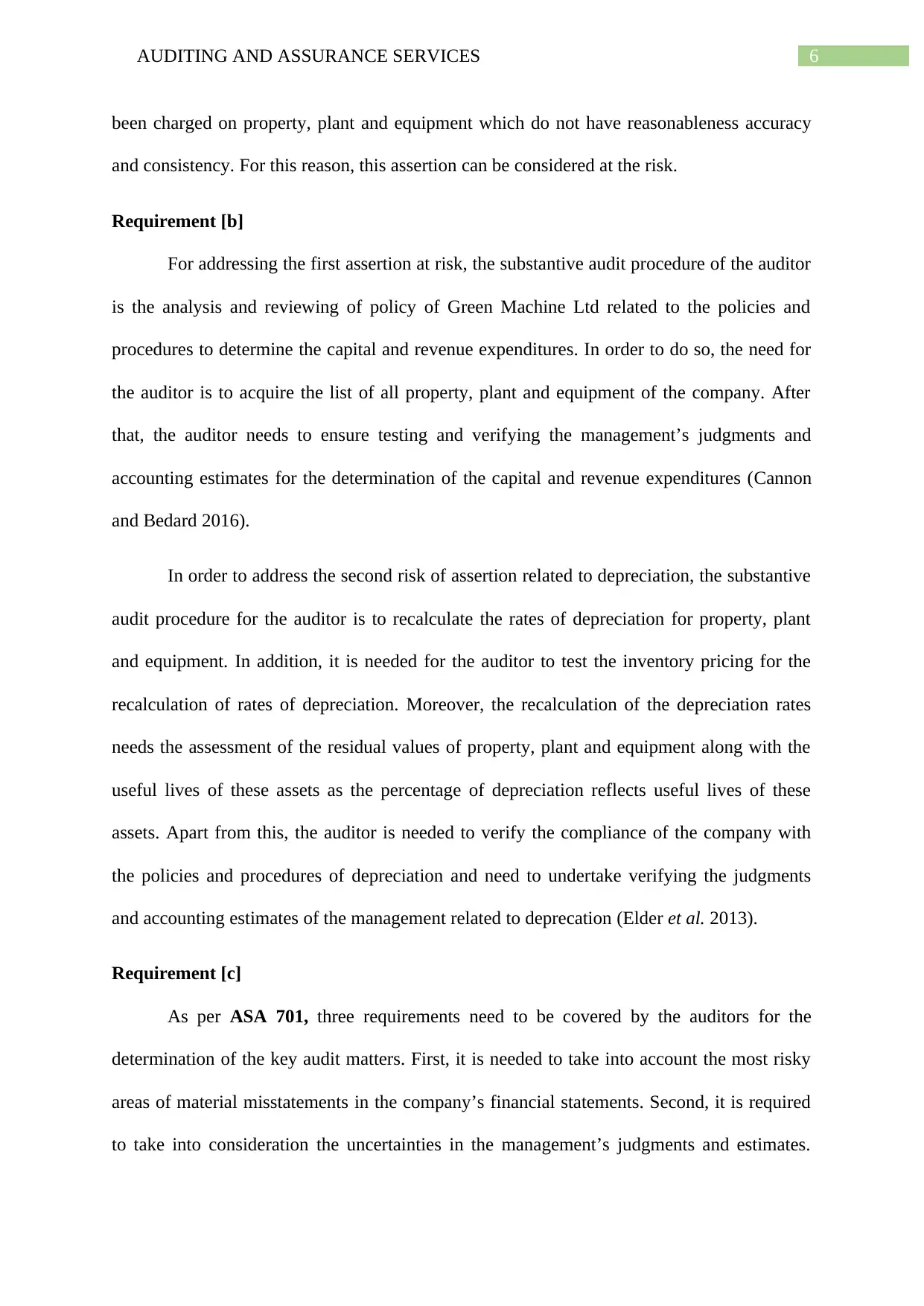
6AUDITING AND ASSURANCE SERVICES
been charged on property, plant and equipment which do not have reasonableness accuracy
and consistency. For this reason, this assertion can be considered at the risk.
Requirement [b]
For addressing the first assertion at risk, the substantive audit procedure of the auditor
is the analysis and reviewing of policy of Green Machine Ltd related to the policies and
procedures to determine the capital and revenue expenditures. In order to do so, the need for
the auditor is to acquire the list of all property, plant and equipment of the company. After
that, the auditor needs to ensure testing and verifying the management’s judgments and
accounting estimates for the determination of the capital and revenue expenditures (Cannon
and Bedard 2016).
In order to address the second risk of assertion related to depreciation, the substantive
audit procedure for the auditor is to recalculate the rates of depreciation for property, plant
and equipment. In addition, it is needed for the auditor to test the inventory pricing for the
recalculation of rates of depreciation. Moreover, the recalculation of the depreciation rates
needs the assessment of the residual values of property, plant and equipment along with the
useful lives of these assets as the percentage of depreciation reflects useful lives of these
assets. Apart from this, the auditor is needed to verify the compliance of the company with
the policies and procedures of depreciation and need to undertake verifying the judgments
and accounting estimates of the management related to deprecation (Elder et al. 2013).
Requirement [c]
As per ASA 701, three requirements need to be covered by the auditors for the
determination of the key audit matters. First, it is needed to take into account the most risky
areas of material misstatements in the company’s financial statements. Second, it is required
to take into consideration the uncertainties in the management’s judgments and estimates.
been charged on property, plant and equipment which do not have reasonableness accuracy
and consistency. For this reason, this assertion can be considered at the risk.
Requirement [b]
For addressing the first assertion at risk, the substantive audit procedure of the auditor
is the analysis and reviewing of policy of Green Machine Ltd related to the policies and
procedures to determine the capital and revenue expenditures. In order to do so, the need for
the auditor is to acquire the list of all property, plant and equipment of the company. After
that, the auditor needs to ensure testing and verifying the management’s judgments and
accounting estimates for the determination of the capital and revenue expenditures (Cannon
and Bedard 2016).
In order to address the second risk of assertion related to depreciation, the substantive
audit procedure for the auditor is to recalculate the rates of depreciation for property, plant
and equipment. In addition, it is needed for the auditor to test the inventory pricing for the
recalculation of rates of depreciation. Moreover, the recalculation of the depreciation rates
needs the assessment of the residual values of property, plant and equipment along with the
useful lives of these assets as the percentage of depreciation reflects useful lives of these
assets. Apart from this, the auditor is needed to verify the compliance of the company with
the policies and procedures of depreciation and need to undertake verifying the judgments
and accounting estimates of the management related to deprecation (Elder et al. 2013).
Requirement [c]
As per ASA 701, three requirements need to be covered by the auditors for the
determination of the key audit matters. First, it is needed to take into account the most risky
areas of material misstatements in the company’s financial statements. Second, it is required
to take into consideration the uncertainties in the management’s judgments and estimates.
Paraphrase This Document
Need a fresh take? Get an instant paraphrase of this document with our AI Paraphraser
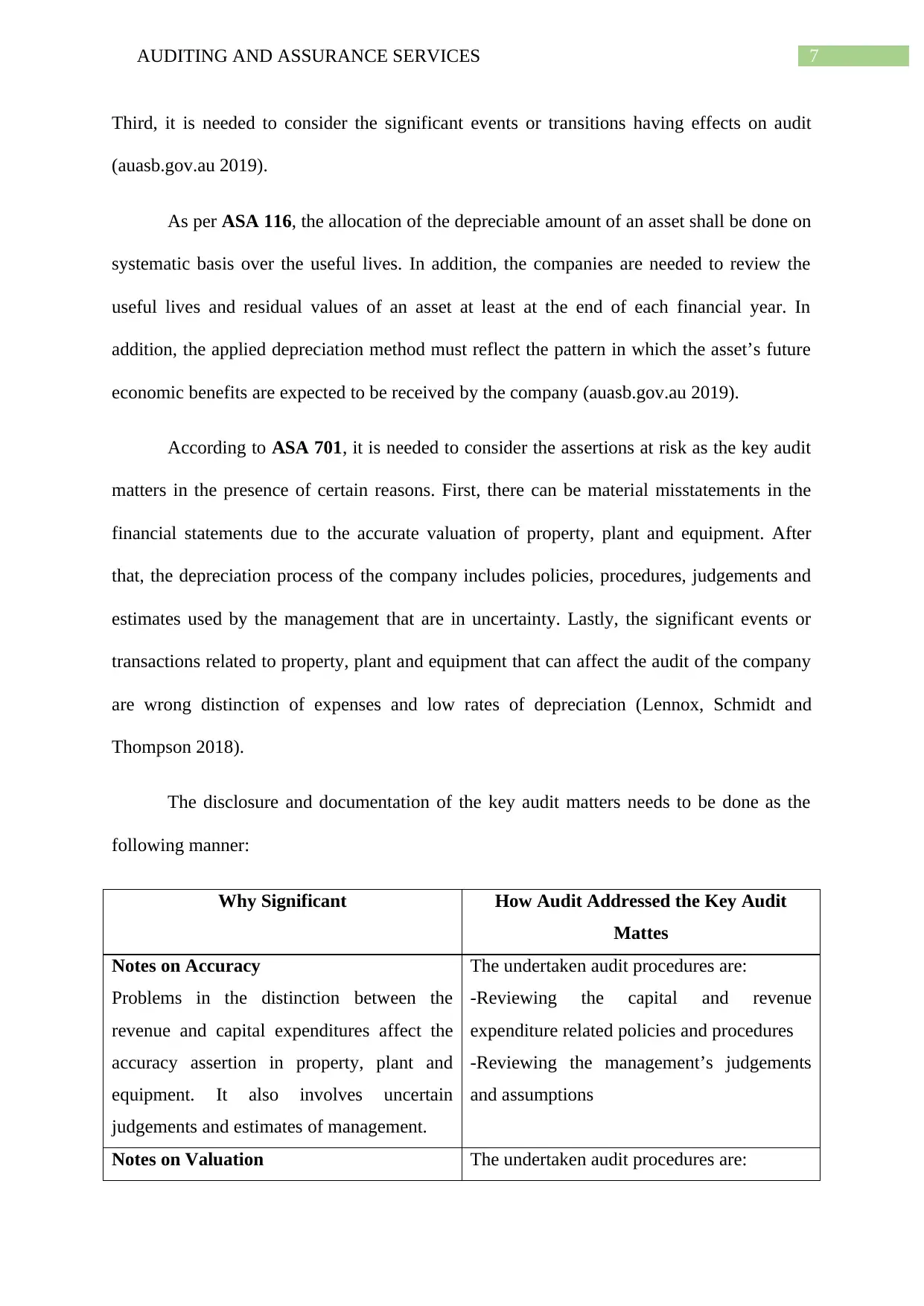
7AUDITING AND ASSURANCE SERVICES
Third, it is needed to consider the significant events or transitions having effects on audit
(auasb.gov.au 2019).
As per ASA 116, the allocation of the depreciable amount of an asset shall be done on
systematic basis over the useful lives. In addition, the companies are needed to review the
useful lives and residual values of an asset at least at the end of each financial year. In
addition, the applied depreciation method must reflect the pattern in which the asset’s future
economic benefits are expected to be received by the company (auasb.gov.au 2019).
According to ASA 701, it is needed to consider the assertions at risk as the key audit
matters in the presence of certain reasons. First, there can be material misstatements in the
financial statements due to the accurate valuation of property, plant and equipment. After
that, the depreciation process of the company includes policies, procedures, judgements and
estimates used by the management that are in uncertainty. Lastly, the significant events or
transactions related to property, plant and equipment that can affect the audit of the company
are wrong distinction of expenses and low rates of depreciation (Lennox, Schmidt and
Thompson 2018).
The disclosure and documentation of the key audit matters needs to be done as the
following manner:
Why Significant How Audit Addressed the Key Audit
Mattes
Notes on Accuracy
Problems in the distinction between the
revenue and capital expenditures affect the
accuracy assertion in property, plant and
equipment. It also involves uncertain
judgements and estimates of management.
The undertaken audit procedures are:
-Reviewing the capital and revenue
expenditure related policies and procedures
-Reviewing the management’s judgements
and assumptions
Notes on Valuation The undertaken audit procedures are:
Third, it is needed to consider the significant events or transitions having effects on audit
(auasb.gov.au 2019).
As per ASA 116, the allocation of the depreciable amount of an asset shall be done on
systematic basis over the useful lives. In addition, the companies are needed to review the
useful lives and residual values of an asset at least at the end of each financial year. In
addition, the applied depreciation method must reflect the pattern in which the asset’s future
economic benefits are expected to be received by the company (auasb.gov.au 2019).
According to ASA 701, it is needed to consider the assertions at risk as the key audit
matters in the presence of certain reasons. First, there can be material misstatements in the
financial statements due to the accurate valuation of property, plant and equipment. After
that, the depreciation process of the company includes policies, procedures, judgements and
estimates used by the management that are in uncertainty. Lastly, the significant events or
transactions related to property, plant and equipment that can affect the audit of the company
are wrong distinction of expenses and low rates of depreciation (Lennox, Schmidt and
Thompson 2018).
The disclosure and documentation of the key audit matters needs to be done as the
following manner:
Why Significant How Audit Addressed the Key Audit
Mattes
Notes on Accuracy
Problems in the distinction between the
revenue and capital expenditures affect the
accuracy assertion in property, plant and
equipment. It also involves uncertain
judgements and estimates of management.
The undertaken audit procedures are:
-Reviewing the capital and revenue
expenditure related policies and procedures
-Reviewing the management’s judgements
and assumptions
Notes on Valuation The undertaken audit procedures are:
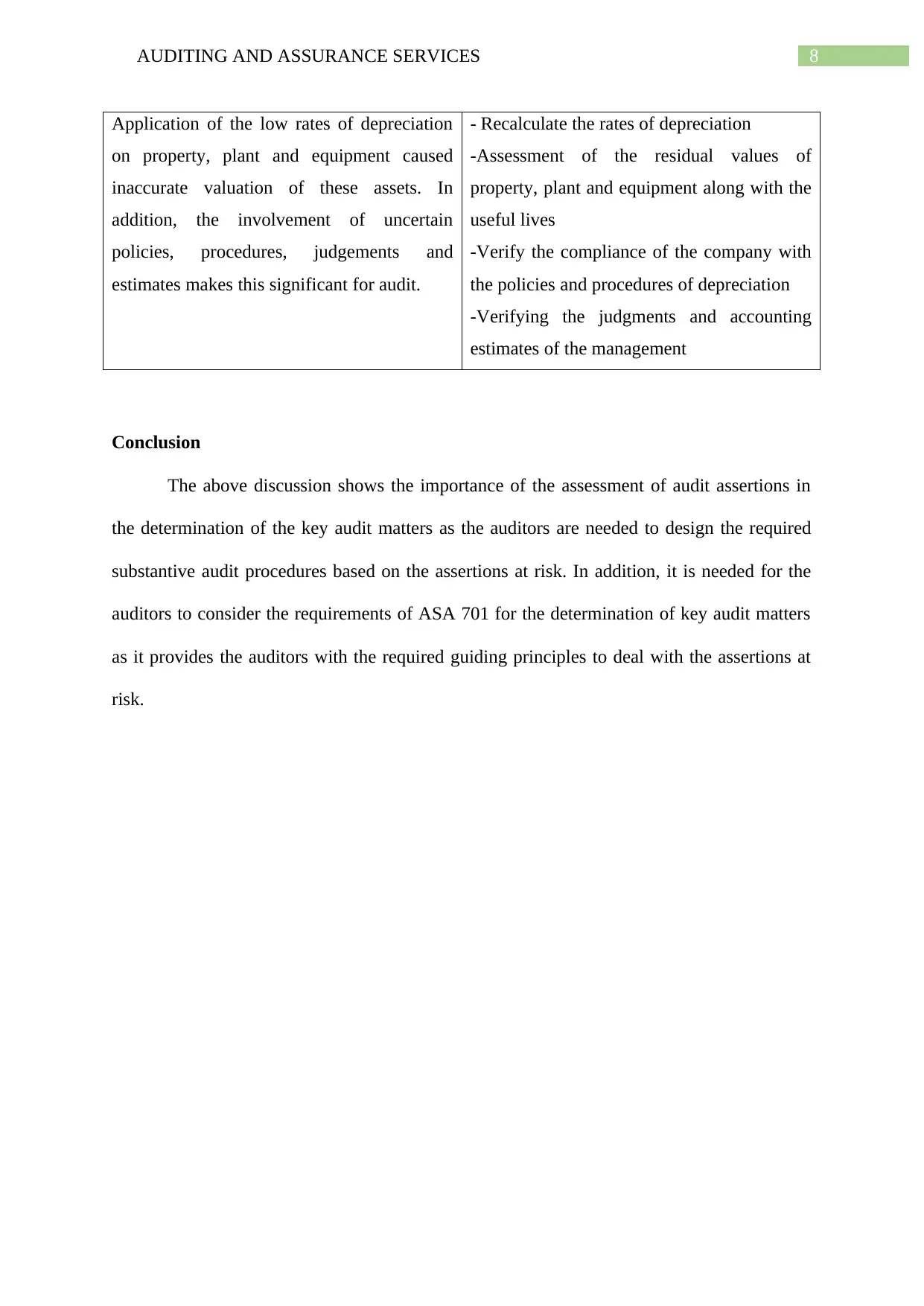
8AUDITING AND ASSURANCE SERVICES
Application of the low rates of depreciation
on property, plant and equipment caused
inaccurate valuation of these assets. In
addition, the involvement of uncertain
policies, procedures, judgements and
estimates makes this significant for audit.
- Recalculate the rates of depreciation
-Assessment of the residual values of
property, plant and equipment along with the
useful lives
-Verify the compliance of the company with
the policies and procedures of depreciation
-Verifying the judgments and accounting
estimates of the management
Conclusion
The above discussion shows the importance of the assessment of audit assertions in
the determination of the key audit matters as the auditors are needed to design the required
substantive audit procedures based on the assertions at risk. In addition, it is needed for the
auditors to consider the requirements of ASA 701 for the determination of key audit matters
as it provides the auditors with the required guiding principles to deal with the assertions at
risk.
Application of the low rates of depreciation
on property, plant and equipment caused
inaccurate valuation of these assets. In
addition, the involvement of uncertain
policies, procedures, judgements and
estimates makes this significant for audit.
- Recalculate the rates of depreciation
-Assessment of the residual values of
property, plant and equipment along with the
useful lives
-Verify the compliance of the company with
the policies and procedures of depreciation
-Verifying the judgments and accounting
estimates of the management
Conclusion
The above discussion shows the importance of the assessment of audit assertions in
the determination of the key audit matters as the auditors are needed to design the required
substantive audit procedures based on the assertions at risk. In addition, it is needed for the
auditors to consider the requirements of ASA 701 for the determination of key audit matters
as it provides the auditors with the required guiding principles to deal with the assertions at
risk.
⊘ This is a preview!⊘
Do you want full access?
Subscribe today to unlock all pages.

Trusted by 1+ million students worldwide
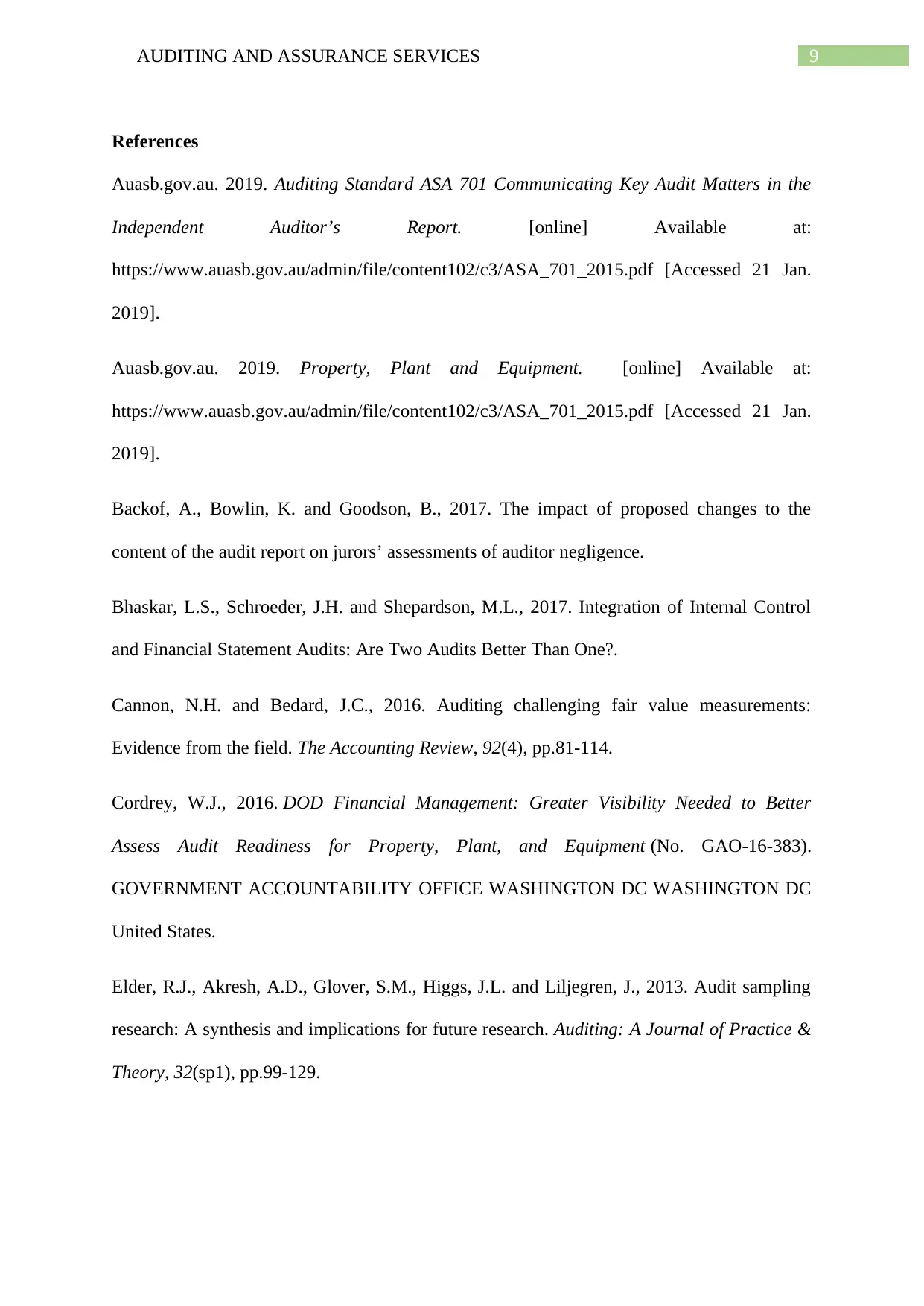
9AUDITING AND ASSURANCE SERVICES
References
Auasb.gov.au. 2019. Auditing Standard ASA 701 Communicating Key Audit Matters in the
Independent Auditor’s Report. [online] Available at:
https://www.auasb.gov.au/admin/file/content102/c3/ASA_701_2015.pdf [Accessed 21 Jan.
2019].
Auasb.gov.au. 2019. Property, Plant and Equipment. [online] Available at:
https://www.auasb.gov.au/admin/file/content102/c3/ASA_701_2015.pdf [Accessed 21 Jan.
2019].
Backof, A., Bowlin, K. and Goodson, B., 2017. The impact of proposed changes to the
content of the audit report on jurors’ assessments of auditor negligence.
Bhaskar, L.S., Schroeder, J.H. and Shepardson, M.L., 2017. Integration of Internal Control
and Financial Statement Audits: Are Two Audits Better Than One?.
Cannon, N.H. and Bedard, J.C., 2016. Auditing challenging fair value measurements:
Evidence from the field. The Accounting Review, 92(4), pp.81-114.
Cordrey, W.J., 2016. DOD Financial Management: Greater Visibility Needed to Better
Assess Audit Readiness for Property, Plant, and Equipment (No. GAO-16-383).
GOVERNMENT ACCOUNTABILITY OFFICE WASHINGTON DC WASHINGTON DC
United States.
Elder, R.J., Akresh, A.D., Glover, S.M., Higgs, J.L. and Liljegren, J., 2013. Audit sampling
research: A synthesis and implications for future research. Auditing: A Journal of Practice &
Theory, 32(sp1), pp.99-129.
References
Auasb.gov.au. 2019. Auditing Standard ASA 701 Communicating Key Audit Matters in the
Independent Auditor’s Report. [online] Available at:
https://www.auasb.gov.au/admin/file/content102/c3/ASA_701_2015.pdf [Accessed 21 Jan.
2019].
Auasb.gov.au. 2019. Property, Plant and Equipment. [online] Available at:
https://www.auasb.gov.au/admin/file/content102/c3/ASA_701_2015.pdf [Accessed 21 Jan.
2019].
Backof, A., Bowlin, K. and Goodson, B., 2017. The impact of proposed changes to the
content of the audit report on jurors’ assessments of auditor negligence.
Bhaskar, L.S., Schroeder, J.H. and Shepardson, M.L., 2017. Integration of Internal Control
and Financial Statement Audits: Are Two Audits Better Than One?.
Cannon, N.H. and Bedard, J.C., 2016. Auditing challenging fair value measurements:
Evidence from the field. The Accounting Review, 92(4), pp.81-114.
Cordrey, W.J., 2016. DOD Financial Management: Greater Visibility Needed to Better
Assess Audit Readiness for Property, Plant, and Equipment (No. GAO-16-383).
GOVERNMENT ACCOUNTABILITY OFFICE WASHINGTON DC WASHINGTON DC
United States.
Elder, R.J., Akresh, A.D., Glover, S.M., Higgs, J.L. and Liljegren, J., 2013. Audit sampling
research: A synthesis and implications for future research. Auditing: A Journal of Practice &
Theory, 32(sp1), pp.99-129.
Paraphrase This Document
Need a fresh take? Get an instant paraphrase of this document with our AI Paraphraser
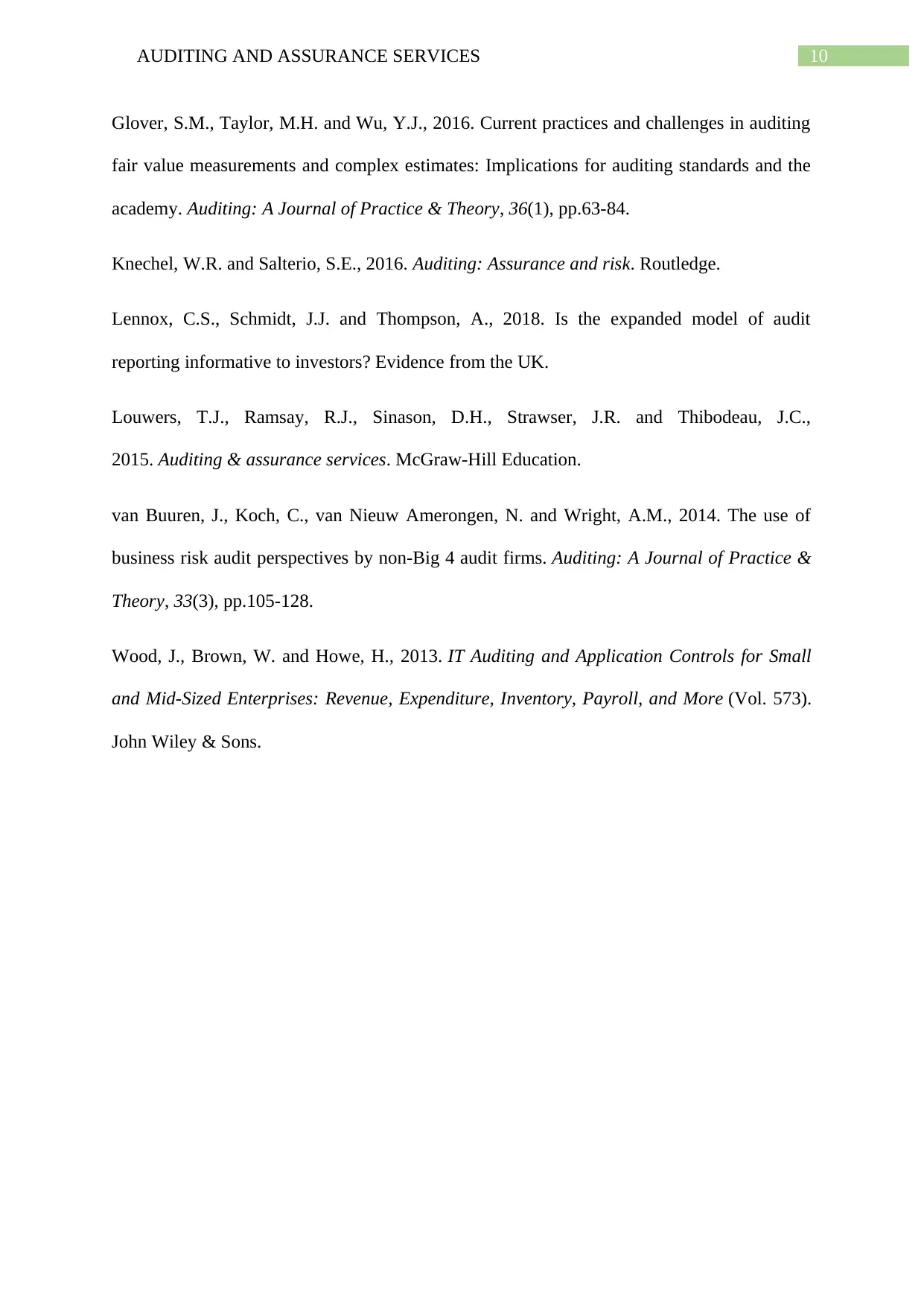
10AUDITING AND ASSURANCE SERVICES
Glover, S.M., Taylor, M.H. and Wu, Y.J., 2016. Current practices and challenges in auditing
fair value measurements and complex estimates: Implications for auditing standards and the
academy. Auditing: A Journal of Practice & Theory, 36(1), pp.63-84.
Knechel, W.R. and Salterio, S.E., 2016. Auditing: Assurance and risk. Routledge.
Lennox, C.S., Schmidt, J.J. and Thompson, A., 2018. Is the expanded model of audit
reporting informative to investors? Evidence from the UK.
Louwers, T.J., Ramsay, R.J., Sinason, D.H., Strawser, J.R. and Thibodeau, J.C.,
2015. Auditing & assurance services. McGraw-Hill Education.
van Buuren, J., Koch, C., van Nieuw Amerongen, N. and Wright, A.M., 2014. The use of
business risk audit perspectives by non-Big 4 audit firms. Auditing: A Journal of Practice &
Theory, 33(3), pp.105-128.
Wood, J., Brown, W. and Howe, H., 2013. IT Auditing and Application Controls for Small
and Mid-Sized Enterprises: Revenue, Expenditure, Inventory, Payroll, and More (Vol. 573).
John Wiley & Sons.
Glover, S.M., Taylor, M.H. and Wu, Y.J., 2016. Current practices and challenges in auditing
fair value measurements and complex estimates: Implications for auditing standards and the
academy. Auditing: A Journal of Practice & Theory, 36(1), pp.63-84.
Knechel, W.R. and Salterio, S.E., 2016. Auditing: Assurance and risk. Routledge.
Lennox, C.S., Schmidt, J.J. and Thompson, A., 2018. Is the expanded model of audit
reporting informative to investors? Evidence from the UK.
Louwers, T.J., Ramsay, R.J., Sinason, D.H., Strawser, J.R. and Thibodeau, J.C.,
2015. Auditing & assurance services. McGraw-Hill Education.
van Buuren, J., Koch, C., van Nieuw Amerongen, N. and Wright, A.M., 2014. The use of
business risk audit perspectives by non-Big 4 audit firms. Auditing: A Journal of Practice &
Theory, 33(3), pp.105-128.
Wood, J., Brown, W. and Howe, H., 2013. IT Auditing and Application Controls for Small
and Mid-Sized Enterprises: Revenue, Expenditure, Inventory, Payroll, and More (Vol. 573).
John Wiley & Sons.
1 out of 11
Related Documents
Your All-in-One AI-Powered Toolkit for Academic Success.
+13062052269
info@desklib.com
Available 24*7 on WhatsApp / Email
![[object Object]](/_next/static/media/star-bottom.7253800d.svg)
Unlock your academic potential
Copyright © 2020–2025 A2Z Services. All Rights Reserved. Developed and managed by ZUCOL.




